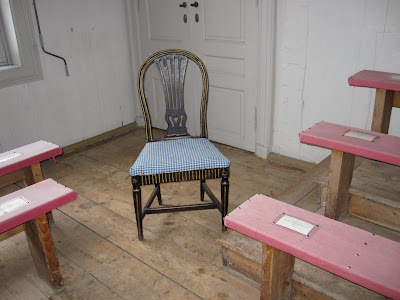This blog has been languishing lately--my apologies! I think we have spent the last several weeks just doing the same old, same old. The kids have been busy at school, and we are biding our time, enjoying slightly warmer weather (just above freezing) and starting to think that winter may actually come to an end at some point.
A couple weeks ago we did break out of the routine to make a trip up to Eidsvoll (maybe 30-40 minutes away) to visit the Eisdvoll Manor, where the Norwegian constitution was written and signed in 1814. Because it is the off-season for tourists, we were basically the only ones there and had our own private tour with a great tour guide. She obviously had experience with school groups and kids--she found all kinds of little nooks and crannies and things the kids found interesting.
On the top floor of the main house is the large, open room that was used for the constitutional assembly. I think there were 112 representatives from all over the country who gathered. The labels on the benches show mark each representative's seat.
Apparently, they were one space short, so a chair was brought in. We all agreed that the person in the chair probably had the best seat in the house (apart from the chairs on the dais where they took turns as chairman and secretary).
Following the Napoleonic wars, the Russians and British wanted to punish Denmark for siding with Napoleon (Norway was under Denmark at the time). They determined that Norway should be given to Sweden as a spoil of war. The crown prince of Denmark, Christian Frederick, had an interest in Norway and helped some of the political leaders generate enthusiasm for a Norwegian constitution. Christian Frederick thought he should be able to declare himself king, but the constitutional assembly convinced him that there must be a vote. He agreed, but only if his was the only name on the ballot, and write-in candidates were not allowed! He was elected king (surprise) and then took two days to "think it over" before accepting. The constitution was signed on 17 May, 1814, but the independence of Norway lasted only until July of that same year, when the Swedes took Norway by force. However, the Swedish king allowed the Norwegians to maintain their new constitution and their parliament (the Storting). This makes the Norwegian constitution second only to the United States as the oldest constitution still in use--having been amended but not completely re-written. 17 May here is like the 4th of July in the U.S., with huge celebrations and parades (look for a future post on this blog!).
 |
| Billiards room--note the cool candle holders around the perimeter to light the table |
 |
| This is a lovely "painted ceiling" which is actually just a painting glued on to the ceiling! |






No comments:
Post a Comment